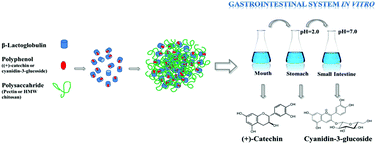In vitro evaluation of the effects of protein–polyphenol–polysaccharide interactions on (+)-catechin and cyanidin-3-glucoside bioaccessibility
Abstract
The bioaccessibility of cyanidin-3-glucoside and (+)-catechin in model solutions when β-lactoglobulin (β-LG) and pectin/chitosan are present was investigated using an in vitro model simulating gastrointestinal conditions. In the mouth, the free cyanidin content increased (+) 90 and 14% while the (+)-catechin content decreased (−) 23 and 13%, respectively for mixtures with -pectin and -β-LG–pectin. Under gastric conditions, the cyanidin content decreased 85 and 28% for mixtures with -pectin and -β-LG–pectin. On the contrary, after gastric digestion, (+)-catechin bioaccessibility increased and exhibited values similar to the original samples for all the systems tested. The transition to the intestinal environment induced a significant alteration on both polyphenols and this effect was more marked for cyanidin. Systems with pectin allowed obtaining a higher content of bioaccessible cyanidin. The gastric conditions promoted an increase in the antioxidant capacity, followed by a decrease of it in the intestine. The free (+)-catechin and cyanidin-3-glucoside contents decreased when exposed to the gastrointestinal tract conditions. However, when incorporated in food matrix components, the gastrointestinal tract may act positively on the extraction of polyphenols, since they are progressively released from protein and polysaccharide bonds, being available for the absorption and to exert their biological effects.


 Please wait while we load your content...
Please wait while we load your content...